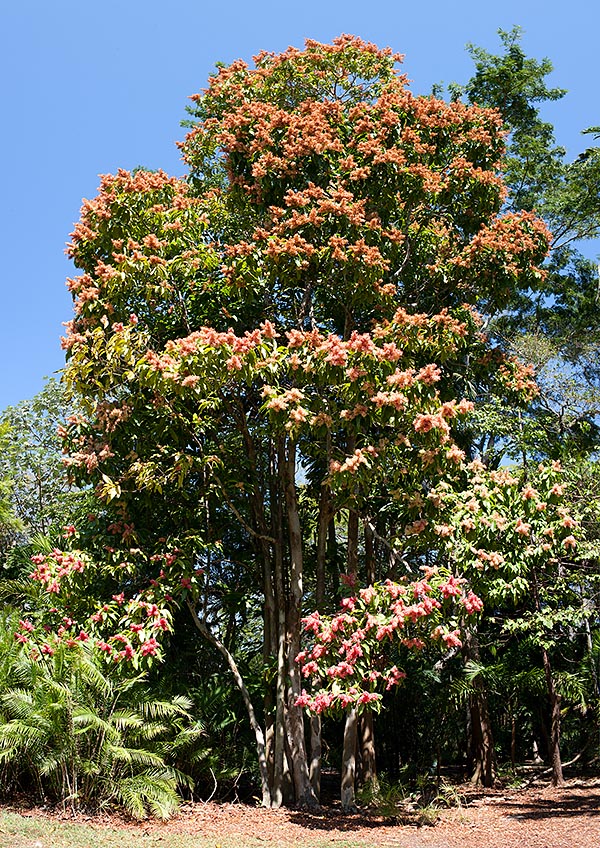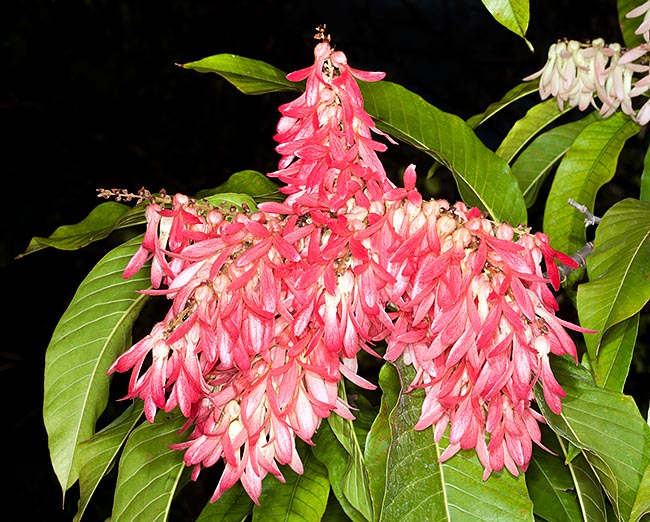Family : Polygonaceae

Text © Pietro Puccio

English translation by Mario Beltramini

Triplaris cummngiana is a dioecious tree which may be 20 m tall © Giuseppe Mazza
The species is native to Colombia, Ecuador, Panama, Peru and Venezuela, where it grows in the humid forests at low and medium altitudes.
The name of the genus comes from the Latin “triplex” = triple, with reference to the parts of the flower; the species is honoured to the English naturalist and collector Hugh Cuming (1791-1865).
Common names: ant tree, long John tree (English); pau-formiga (Portuguese-Brazil); dilla, Fernán Sánchez, guayabo hormiguero, muchín, muchina, palo mulato, palo santo, roblón, San Fernando, tangarana, vara santa (Spanish).
The Triplaris cumingiana Fisch. & C.A.Mey (1845) is an evergreen or semi-deciduous dioecious (each single individual carries either only male flowers or female flowers) tree, up to about 20 m tall, with erect trunk, up to 45 cm of diameter, with smooth, externally grey, internally pale brown, bark, which flakes patchy in thin stripes, and almost columnar crown; the branches are hollow and in the origin places host particularly aggressive ants (Pseudomyrmex triplaridis Forel).
The leaves, on a 0,6-2 cm long petiole, are alternate, simple, oblong, with prominent veins, entire margin and pointed apex, of 22-35 cm of length and 7-12 cm of breadth, of glossy intense green colour on the upper page, paler below, and brown down along the central vein.
The inflorescences generate at the terminal axils, the male ones are spikes long up to more than 30 cm covered by a pale brown down, with white-greenish flowers of about 0,5 cm of length and of diameter, sub-sessile (almost devoid of peduncle), formed by a pubescent funnel-shaped calyx with 6 lobes and 9 stamina.
The female inflorescences are up to about 20 cm long with flowers, on a 0,2-0,8 cm long peduncle, formed by a globose tubular calyx, about 1 cm long, with three lobes, whitish initially, and three petals; the lobes, after the opening of the flower, elongate forming three oblong wings up to about 4,5 cm of length and 0,6 cm of breadth, of reddish pink colour.
The fruits are ellipsoid, pubescent, achenes, about 1,2 cm long, of pale brown colour when completely ripe, with the three persistent wings derived from the lobes of the calyx, containing one pointed seed, with triangular section, about 1 cm long, of glossy brown colour.

The even 20 cm long female inflorescences have tubular calyces with 3 pink lobes of 4,5 cm © Giuseppe Mazza
The fruits are dispersed by the wind, even far away, by turning around the vertical axis.
It reproduces by seed, in sandy soil kept humid at the temperature of 22-24 °C, with germination times of 2-6 weeks and by cutting.
Species of remarkable ornamental value, for the foliage as well as for its spectacular flowering, cultivable in full sun, or slight shade, in the tropical and subtropical climate zones, it can resist for a very short period to temperatures up to -2 °C, but with damage to the foliage.
It requires a soil rich in organic substance, acidic or neutral, kept humid, even if well rooted specimens can bear short periods of dryness.
Besides as isolated specimen in parks and gardens, it is at times utilized as shadow tree and for producing, with the fallen leaves, biomass useful to maintain the humidity of the soil in the coffee plantations.
The wood, easy to work, is utilized for furniture, construction in general and indoor finish, properly protected, as it easily decays with the humidity and is attacked by the xylophagous insects.
Synonyms: Triplaris guayaquilensis Wedd. (1849); Triplaris lindeniana Wedd. (1849); Triplaris arnottiana Meisn. (1856); Triplaris auriculata Meisn. (1856).
→ To appreciate the biodiversity within the POLYGONACEAE family please click here.
